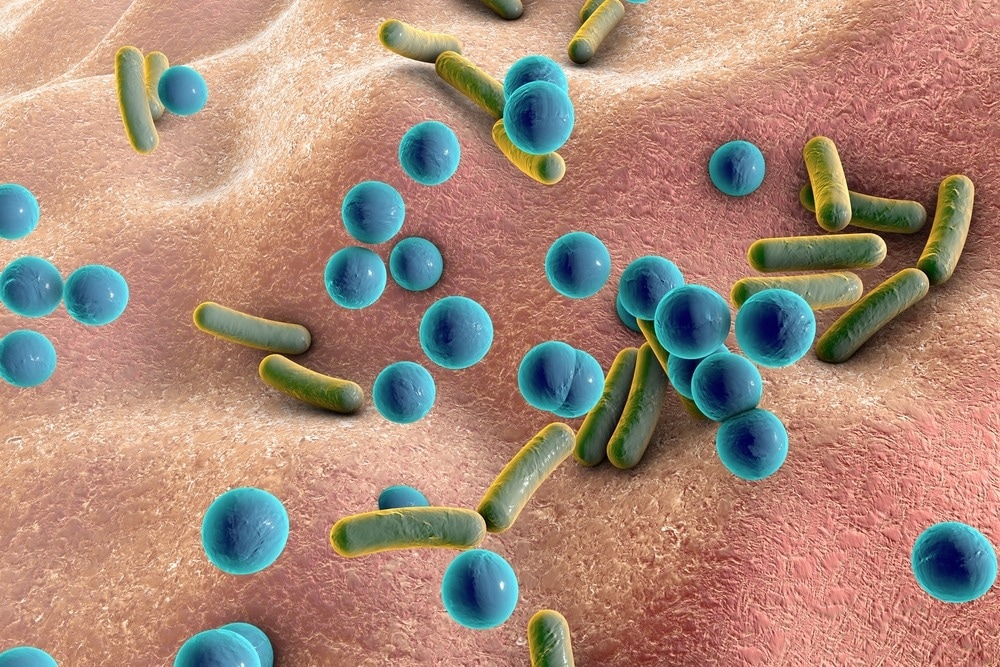Human skin harbors a wide range of microorganisms, including fungi, bacteria, and viruses. In fact, recent estimates indicate that over 1011 microbial cells could be present on skin surfaces.
Typically, the abundance and composition of microorganisms vary with specific conditions of different areas of the skin. Some of the bacterial genera that are dominantly found on the skin include Cutibacterium, Staphylococcus, and Corynebacterium.

Study: A New Model to Investigate the Effects of Cosmetics on Skin Microorganisms In Vitro. Image Credit: Kateryna Kon / Shutterstock.com
Background
Numerous prebiotic supplements have been used in cosmetics to promote the growth of beneficial bacteria, such as coagulase-negative Staphylococci, while suppressing Cutibacterium growth.
Prebiotics have an important role in rebalancing the skin microbiota by enhancing the growth of beneficial microbes and inhibiting pathogenic growth. Putative prebiotics can be obtained from various sugars, natural extracts, and fermented products of bacteria.
A recent Cosmetics journal study discusses the development of a leather-based in vitro model due to its close resemblance to human skin. The model was used to investigate the role of cosmetic ingredients on bacterial growth under realistic conditions.
About the study
Seven ubiquitous Gram-positive skin bacteria were selected to analyze how they were affected by the tested prebiotic actives. The actives used in this study included plant-based glycerol, diglycerol, glyceryl caprylate, and multifunctional ingredient.
The pH of all active ingredients was adjusted and thickened by the addition of acacia senegal gum and xanthan gum. Serum without the active ingredients was used as control.
The growth curve for each bacteria strain was recorded in the absence or presence of the active ingredients. To evaluate the effect of cosmetic serum on skin microbes under more realistic conditions, a leather model mimicking human skin was developed.
Study findings
The possibility of microbial growth or growth inhibition was studied using liquid culture media that contained prebiotic actives at different concentrations. The culture media with a greater optical density (OD) at a given time indicated the promotion of bacterial growth. Similarly, cultures with lower ODs indicated bacterial growth inhibition.
The promotion of Corynebacterium jeikeium growth and partial inhibition of Micrococci were observed. Even at a higher concentration of prebiotic actives, most bacterial strains remained unaffected.
Varied growth outcomes were observed for some Staphylococci species. For example, maximum growth promotion was observed in S. aureus and S. hominis, while S. epidermidis remained unaffected.
Dissimilarity in microbial growth promotion and inhibitory effects might be observed between in vivo and in vitro experiments using similar microbial strains and active ingredients. This is because the complexities of the interaction between bacteria and skin cells cannot be analyzed in a cell-culture-based model.
In contrast, the leather skin model mimicked important characteristics of human skin, including bacterial adhesion and absorption of the cosmetic formula.
The newly developed leather skin model helped scientists examine how cosmetic formulas containing prebiotic actives affected natural bacterial colonizers of the skin. After 30 minutes of treatment with the serum, serum without any added actives exhibited a considerable effect on bacterial colonization. More specifically, the growth of S. epidermidis, S. hominis, and M. flavus was marginally promoted, while S. aureus growth was inhibited.
Although general sera-containing actives exhibited a similar pattern in bacterial colonization, some minor changes and exceptions were observed. As compared to the colonization pattern of serum alone, the addition of actives led to minor alterations, including less pronounced inhibition of S. aureus and a higher rate of C. jeikeium inhibition.
Implications
The leather skin model data indicated that cosmetic treatment impacted skin microbiota in a discriminative manner. Comparisons between skin models treated only with serum and serum-containing actives did not present statistically significant different effects.
In human skin, bacterial strains do not occur singly but in a complex microbial community; thus, assessing the effect of serum-containing actives on a single bacterial strain is not justified. Notably, the growth effects of cosmetic actives on skin microorganisms are generally low.
A manufacturer must consider the leather skin model data to re-confirm whether their cosmetic formula promotes the growth of pathogens like S. aureus. The present model would provide manufacturers with a comprehensive outlook of inhibitory or growth-promoting effects of bacterial species of the skin microbiota.
This model could also be used to study the effect of the skin-derived media, such as sweat or sebum, along with cosmetic formulas, on skin bacteria.
Journal reference:
- Rademacher, M., Zinn, M., Beinio, R., & Bockmühl, D.P. (2022) A New Model to Investigate the Effects of Cosmetics on Skin Microorganisms In Vitro. Cosmetics. 9(4), 88. doi:10.3390/cosmetics9040088.